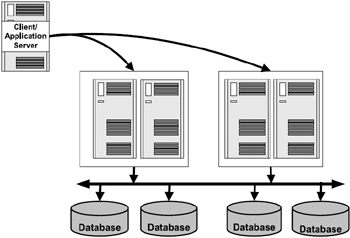2.8 Storage system architectures
|
| < Day Day Up > |
|
Storage is a central component and plays a critical role in the overall protection and availability of data. Disks with large capacity (gigabytes) cause performance problems and result in negative performance gains. For good performance the I/O subsystem should be sized for IOPS (I/O operations per second). One of Oracle's suggestions is a size based on, at most, 40 IOPS per drive. Large gigabyte-sized disks do not help in I/O performance. Disks should be purchased by IOPS and not by size. Actually, more disks of smaller capacity would be of significant benefit.
While the disk or storage specifications are important, the architecture used to store and retrieve information from disks (access patterns) is equally if not more important. The following are the three major access patterns standards in the industry today:
-
Traditional direct attached access model
-
Storage area network (SAN) access model
-
Network attached storage (NAS) access model
2.8.1 Traditional direct attached access model
This access model involves three basic steps: the client or application server requests data from the database server over the network, the database server does disk I/O, and the result is sent to the user or client over the network (Figure 2.21). Although this has been the most popular model because of its simplicity for a considerably long time, this model has several significant drawbacks. The following drawbacks prevent this model from fitting into the high-availability, high-performance architectural goals:

Figure 2.21: Traditional access model.
-
Physical storage cannot be shared with other systems or applications without being served by the host system to which it is attached.
-
Storage must be located physically close to the host system because of I/O bus restrictions on distance and performance.
-
The scalability of number and capacities of devices are limited, depending on the I/O bus and storage technology being used.
-
Because it depends on a host volume manager, there is no dynamic load balancing, expansion options, or RAID without this.
2.8.2 Storage area network (SAN) access model
Under this access model (Figure 2.22) there are three steps required from the point that a request is made and when it is returned back to the user.

Figure 2.22: SAN access model.
-
The client makes a data request over the network to the database server.
-
The database server performs I/O over a fiber channel I/O bus to a RAID configuration.
-
The database server sends results back to the client over the network.
With the plug-and-play feature of the SAN architecture, more storage systems can be configured and shared from the pool, providing scalability at the storage system level. SAN also supports raw device implementations required for RAC on certain hardware platforms.
2.8.3 Network attached storage (NAS) access model
NAS is a high-performance, platform-independent data storage technology that uses hardware and software that is optimized to perform a specific task, namely file service. NAS devices are part of a growing category of appliance-like servers that are easy to set up and manage. They are particularly well suited to network topologies that have a mixture of clients and servers running different operating systems.
NAS devices are a group of small hard-disk drives that connect to a network, usually by Ethernet. Unlike SAN, NAS devices are not slaves to servers. The NAS model links to a network via an Ethernet card, instead of tying a server directly to a storage device. The NAS device with its processor and operating system acts like a server itself. Using Ethernet, NAS circumvents the need for more expensive fiber channel technology, which serves as the backbone for a SAN.
NAS seeks to eliminate network bottlenecks the same way that SANs do but in an easier and more cost-effective fashion. NAS should cost less than SAN over the long term, because they are cheaper to install and expand than SAN. SAN's relatively high cost is attributable to its use of fiber channel technology.
|
| < Day Day Up > |
|
EAN: 2147483647
Pages: 174